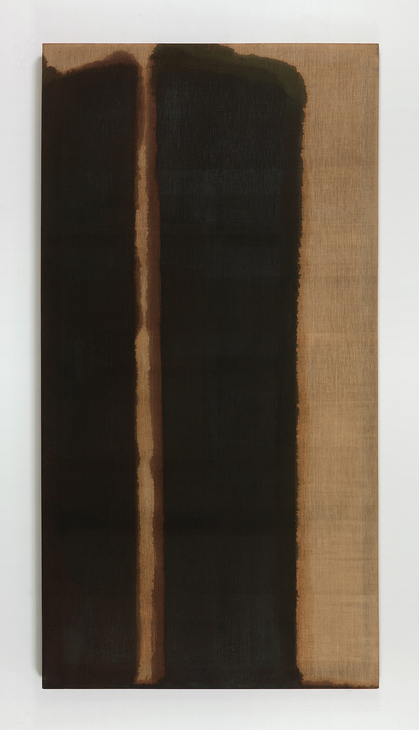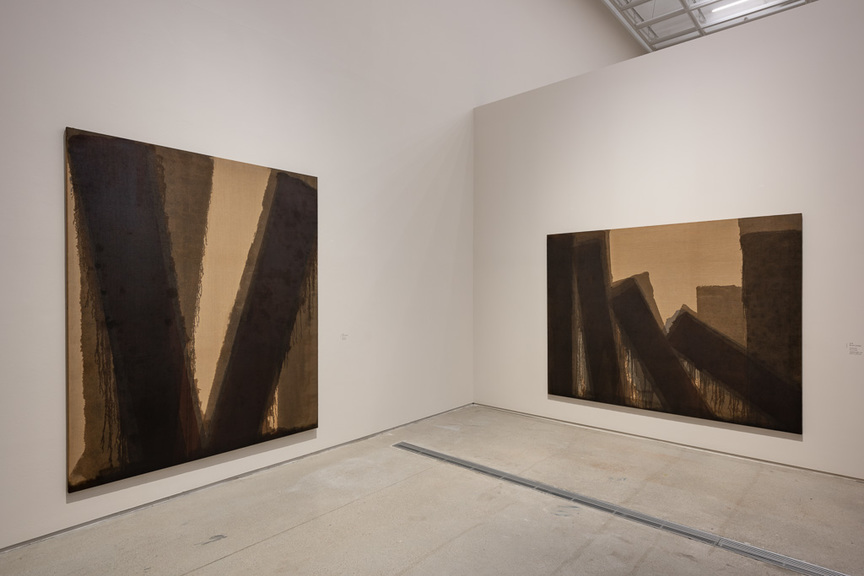-
From Current Issue
-
- Editor’s Letter Fire in the Heart
- Reviews I Gusti Ayu Kadek Murniasih
- Reviews 11th Seoul Mediacity Biennale: “One Escape at a Time”
- Dispatch Networked China
- One on One Monira Al Qadiri on Yukio Mishima
- Essays The rise of independent art spaces in pandemic-era Shanghai
- Features Tuan Andrew Nguyen
- Table of Contents
- Web Exclusives
- Archive
- Subscribe

R
E
V N
E
X
T
Installation view of YUN HYONG-KEUN‘s (left) Burnt Umber & Ultramarine, 1987, oil on linen, 210 × 292 cm, and (right) Burnt Umber & Ultramarine Blue, 1999, oil on linen, 182 × 292 cm, at Yun Hyong-Keun’s retrospective, National Museum of Modern and Contemporary Art (MMCA), Seoul, 2018. All images courtesy the artist and MMCA, Seoul.
When Donald Judd asked Yun Hyong-Keun what art is, the latter responded that art is “artless and bland.” To some viewers of Yun’s paintings—which have been associated with Korean Dansaekhwa—these words may serve as curious descriptors of the late artist’s striking, monochromatic canvases. But, as art critic Shinn Yongduk explains in a documentary on the artist, “Judd understood what Yun really meant. If likening his sentiment to taste, one can eat with greater appreciation when the flavors of the raw ingredients are fully expressed.”
After applying layers of pigment onto a cotton or linen backing, Yun would step aside to allow the materials to speak for themselves. The oil paint, thinned with turpentine, would soak into the warp and weft of the unprimed canvas, creating a complex network of tendrils alongside the painted forms. Indeed, Yun’s lyricism can be found not in the monolithic black pillars that have come to define his artistic style but along their edges, where we can see, in paintings such as Umber Blue (1978), hints of ultramarine (representative of “heaven,” according to the artist) and umber (“earth”) seeping out from beneath the swaths of black to suggest rich pools of color.
Yun Hyong-Keun’s major retrospective at MMCA Seoul, his first in Korea since his death in 2007, offered a thoughtful look at over four decades of his career. Starting with smaller works from the 1960s and ending with a final painting from 2007, the exhibition carefully traced the evolution of the artist’s visual and conceptual concerns. In early paintings such as Title Unknown (circa 1966), Yun experimented with brightly colored abstractions before developing his more somber, mature style. Later works, produced from the late 1980s on, display his engagement with a level of simplicity that had been refined over many years. In “Burnt Umber & Ultramarine” (1990–96), for instance, the once nuanced interplay of colors gives way to an impenetrable blackness that stretches across almost the entirety of the canvas, the paint’s density conveying a sense of stability and certainty.
An extensive chronology presented at the start of the show, along with notebooks and video interviews with Yun’s peers in the final gallery, demonstrated how intertwined art and life were for the artist. These biographical complements provided greater insight into not only the artist’s training and developing sensibility but also his personal hardship at a time when Koreans lived through the trauma of Japanese colonial rule, the Korean War, and a postwar military dictatorship. The accompanying interpretative materials noted that Yun had been incarcerated three times—in one instance, narrowly escaping execution—and that these experiences drove him to paint from a reservoir of anger, frustration, anxiety, and, at times, despair. “Don’t they know that the way of art is the way of suffering?” he wrote in a diary entry from 1986. “When I’m raging with anger, all of the spite inside me soaks through the canvas,” he wrote in another. Perhaps this sense of urgency is felt most acutely in the pair of works, both titled Burnt Umber (1980), that Yun produced in the months following the Gwangju Uprising of May 1980. The once solemn, upright pillars of his earlier paintings topple over and collide with one another, creating a dynamism previously unseen in his canvases. Yet, the dynamism screams of grief and sorrow, the violent drips of paint evoking tears, sweat and blood. Here, the once restrained passion and intensity of the artist play out in an unmistakable cry of pain.
The exhibition closed with a faithful recreation of the artist’s atelier, which he had designed and built in Seogyo-dong and occupied from 1983 until his death. Besides furniture and crafts from the Joseon period, Yun chose to live and work alongside intimate works made by friends and mentors—a painting by Kim Whanki, a sculpture by Choi Jongtae, and a single wall piece by Donald Judd, which archival photographs show Yun used as a shelving unit of sorts. This multifaceted retrospective, which mirrored the art’s quiet yet powerful demeanor, provided a meaningful and long-overdue introduction to Yun’s life and work.
Yun Hyong-Keun’s solo retrospective is on view at the National Museum of Modern and Contemporary Art, Seoul, until December 16, 2018.
To read more of ArtAsiaPacific’s articles, visit our Digital Library.







